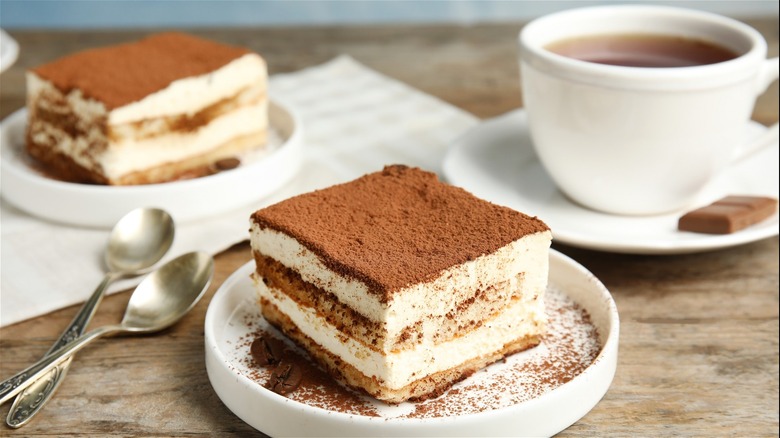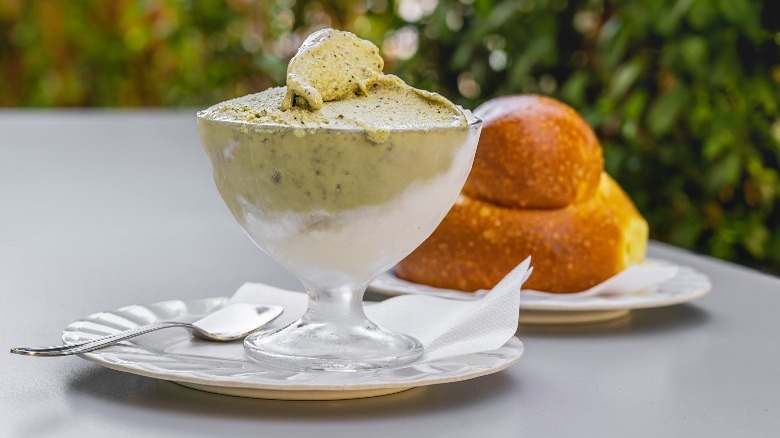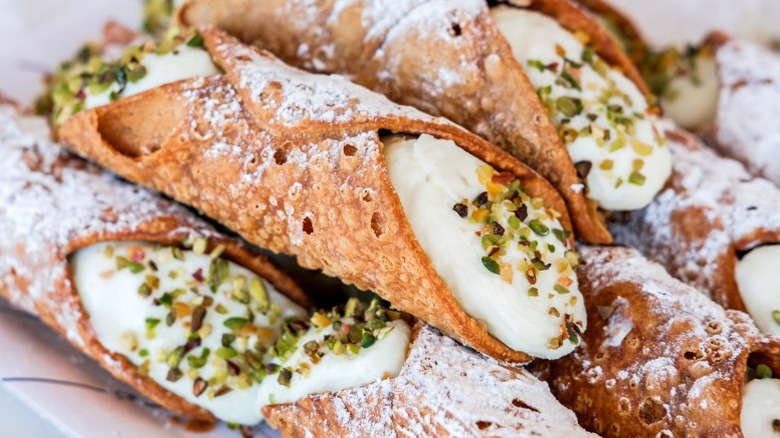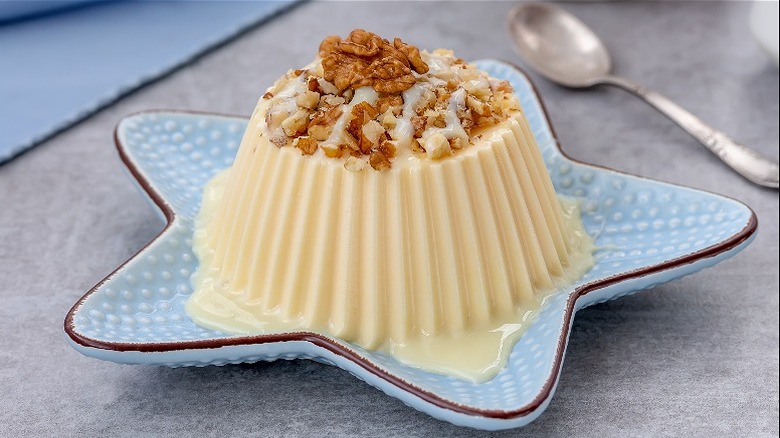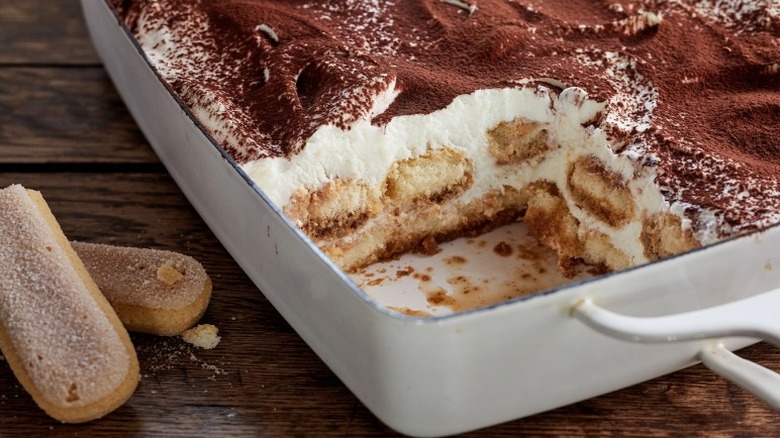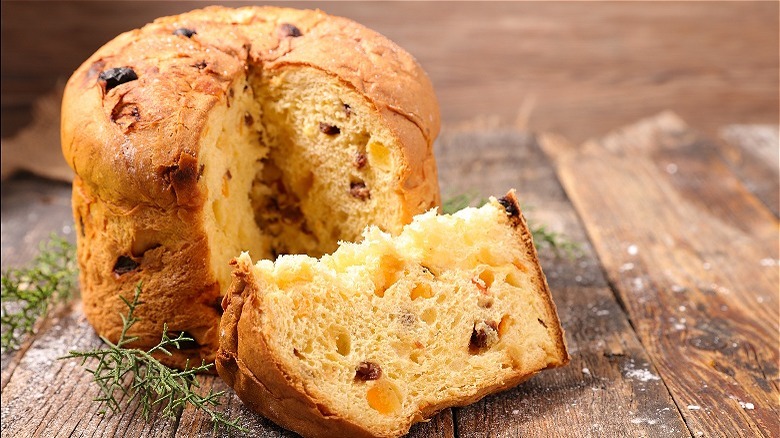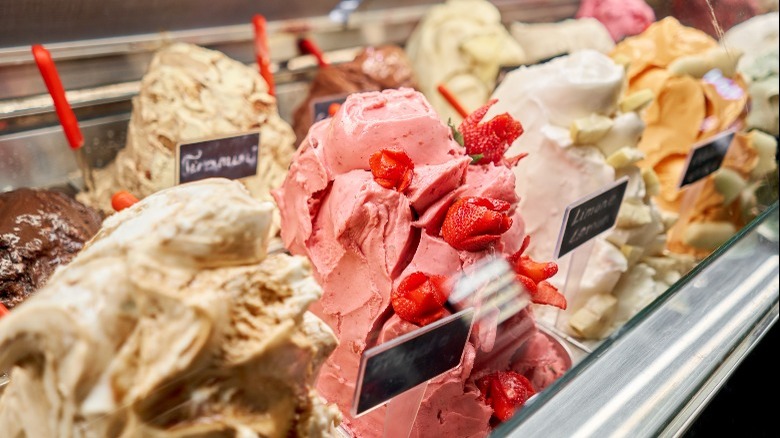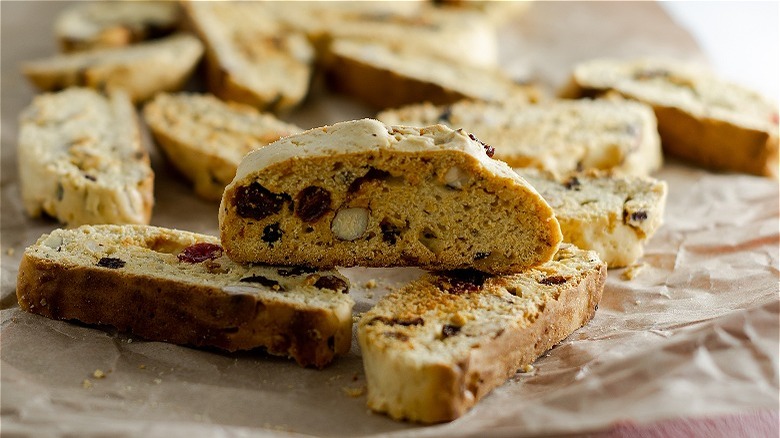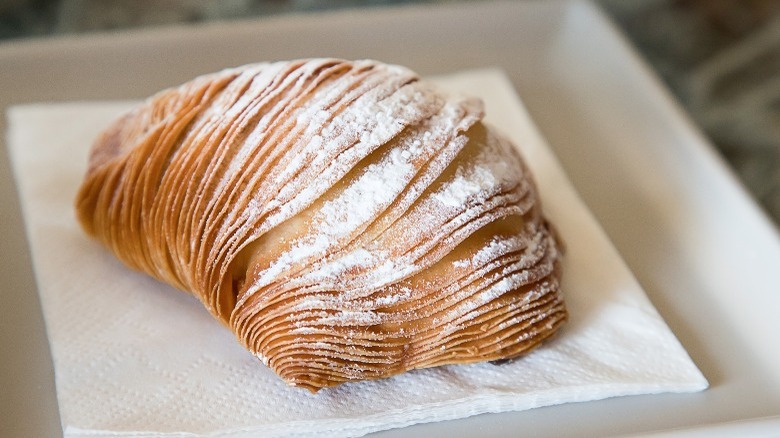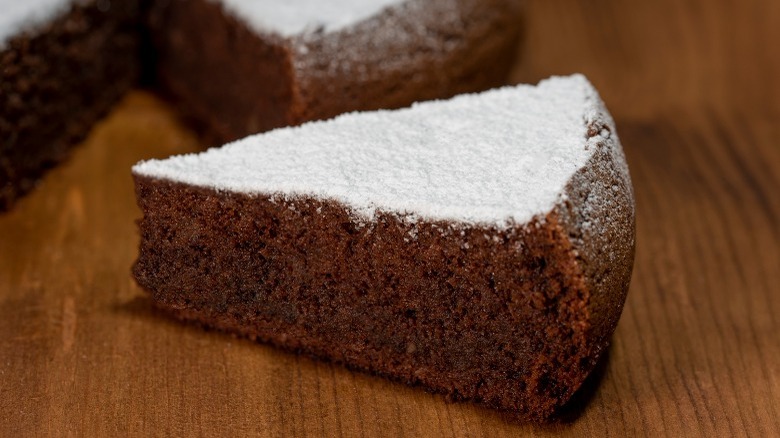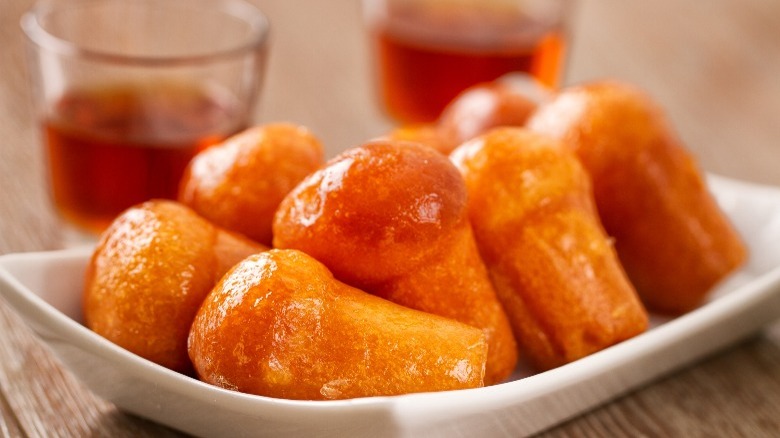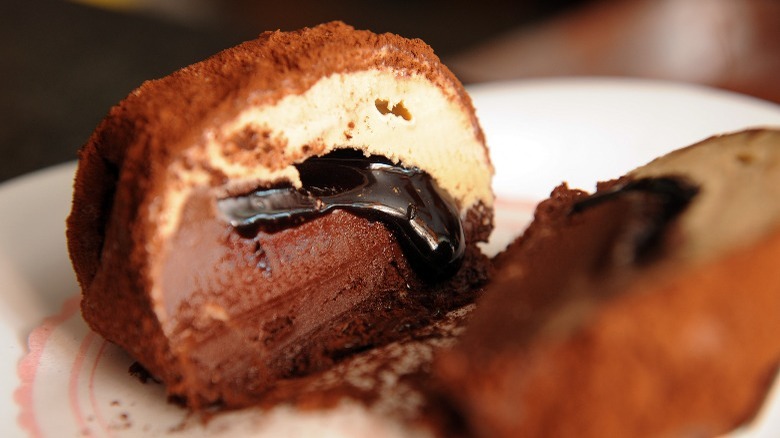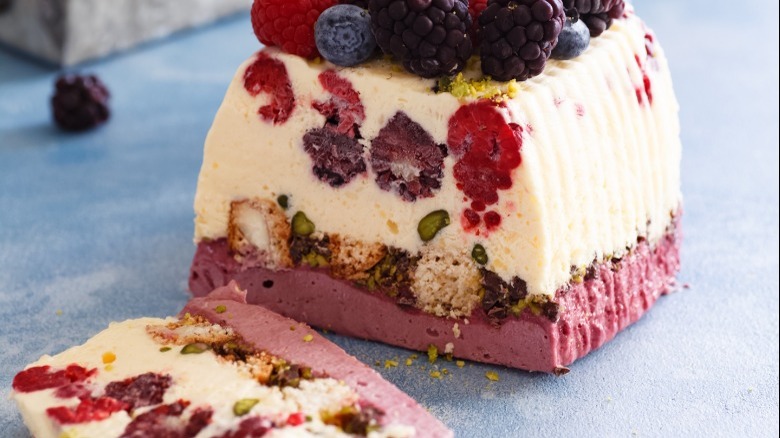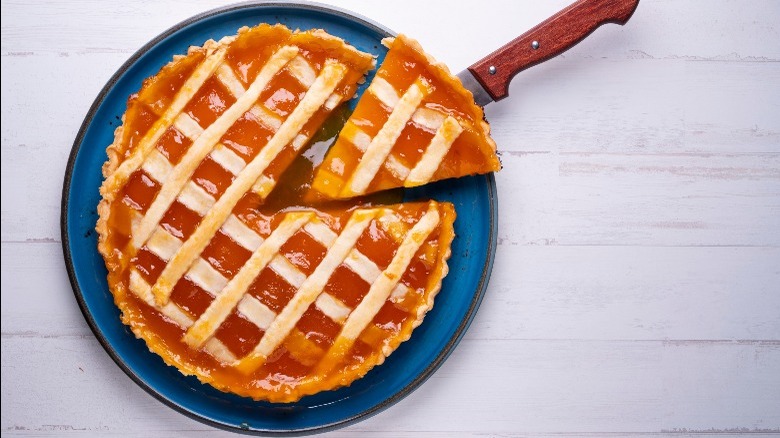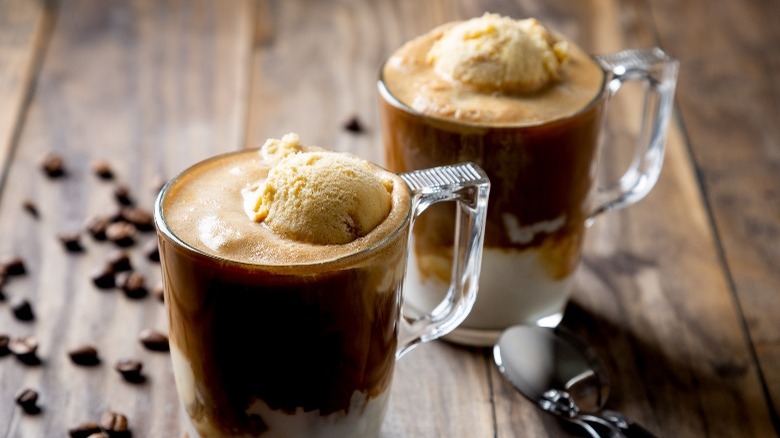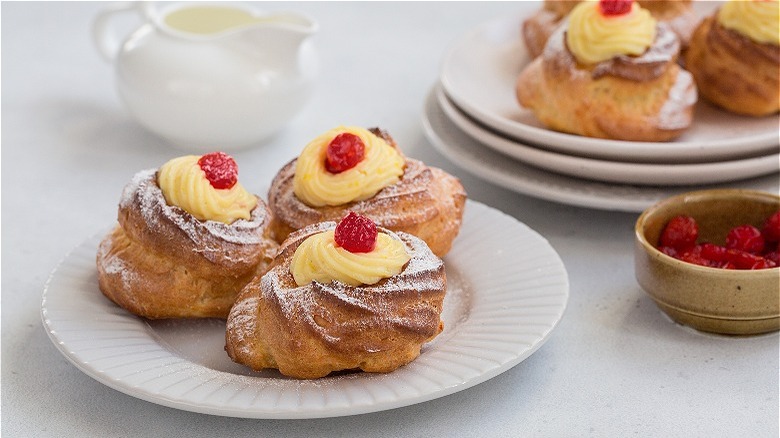15 Types Of Desserts That Will Transport You Straight To Italy
Cannoli, gelato, and biscotti are quintessential Italian desserts. Maybe you are Italian, and eating these treats reminds you of home. Maybe you're an international traveler, and sweets like these revive Italian vacation memories. Whatever the case may be, Italian desserts are special. Eating one offers us a glimpse into iconic Italian food culture.
Italian desserts are highly sophisticated: Rather than eating vanilla ice cream, Italians often enjoy fior di latte gelato, which is a lovely, creamy, milk-based gelato. Italians have their own version of chocolate cake; the chocolatey Torta Caprese is a rich and delightful dessert made with almond flour.
We wouldn't go as far as to call these Italian sweets healthier than American ones. However, they tend to be more subtle, understated, and quite unusual when compared to their American counterparts. The elegance of Italian desserts, combined with their memorable origin stories, are part of what Italian sweets so evocative.
Nuns, monks, and Catholic traditions are more connected to Italian desserts than you might think (via Good Food Stories). Regional factors also play a part in Italian desserts. The Italian regions of Naples, Capri, Tuscany, and Sicily all lay claim to different sweets. The histories and traditions behind these desserts are worth learning about. Knowing a little bit about these confections from Italy tends to make you feel transported and inspired as you enjoy the delectable, sugary deliciousness.
Granita
Granita originates from Sicily, which is a triangle-shaped island located near the bottom of Italy (via Mic.com). Although it's not physically connected to the country, Sicily is a part of Italy (via Britannica). Granita was derived from sherbert, which is made from frozen fruit juice flavored with rose water or jasmine (via Silvia's Trips). Sherbert was brought to Sicily by the Arab people.
According to Silvia's Trips, this Italian dessert caught on when Sicilians began making their own version of sherbet using snow from mountains on the island. Sicilians would scrape natural ice into bits, creating something similar to the granular texture of granita that we know today.
Sherbet and granita are similar frozen desserts involving fruit, but they do not have identical recipes (via MyRecipes). Sherbet typically includes ingredients like dairy or gelatin, which are not used to make granita. Granita is more akin to sorbet, which simply contains fruit and frozen water. However, granita is less finely ground, giving it a rougher texture than sorbet (via Eat Out Eat Well). It is similar to shaved ice.
Popular flavors of granita include almond, pistachio, lemon, mulberry, and coffee (via Italy Magazine). In Sicily, granita is often served with brioche, and diners dip the brioche pastry into a glass of granita (via Visit Italy). But in the Sicilian capital of Palermo, granita is placed in the middle of a cut brioche, like an ice cream sandwich. Whichever way you serve it, this treat is delicious.
Cannoli
Cannoli are another Italian dessert that hails from the island of Sicily (via Experience Sicily). They likely originated during the celebration of Carnevale (a party held just before the start of Lent) in the city of Acireale (via La Cucina Italiana). But these pastries also may have emerged when the Arab people reigned in Sicily from the 10th to 11th centuries. Whenever it came to be, the dessert eventually made its way to America during the 1880s.
According to Cannoli Kitchen, a traditional cannolo (since cannoli is the plural form of the word) is "a tube-shaped shell of fried pastry dough filled with sweet and creamy ricotta, candied fruit, and chocolate filling."
The dough for the shell consists of egg, sugar, flour, lard, and Marsala, which is a type of fortified Italian wine. The dough is shaped by being wrapped around a rod. The whole thing goes into a fryer, and the pastry is then cooked, giving its crunch.
Fillings like mascarpone, custard, whipped cream, or pastry cream sometimes replace a cannolo's ricotta center, but these are less authentic. Toppings usually decorate the ends of the cannoli, where the filling sticks out. Popular topping options for this part of the cannolo include candied cherries, candied oranges, hazelnuts, or chopped pistachios (via Web Food Culture).
Panna Cotta
Panna cotta is an Italian dessert hailing from the Northern Italian region of Piedmont, an area that is famously known for its cheese, wine, and truffles (via Trip Savvy). But as panna cotta is one of the more ubiquitous desserts on Italian restaurant menus, this dessert's fame has clearly spread outside of its Italian region of origin (via La Cucina Italiana). This soft, sweet treat, the name of which translates to "cooked cream," will have you feeling Italian no matter where you are.
According to Taste Atlas, the original recipe for panna cotta involved only sugar, whole cream, gelatin, and vanilla. Sometimes it's flavored with Italian Marsala wine, rum, or caramel sauce. To make this dessert, all the ingredients (aside from gelatin) are slightly cooked (as per Delighted Cooking). Then, gelatin is added, thickening the mixture. Next, the whole thing is put into a mold and cooled in the fridge. Once the panna cotta is as firm as you want it to be, it is ready to be served.
Most of the flavor of panna cotta is derived from its toppings or infusions. As one Quora user explained, "The base of Panna Cotta is, for the most part, milk/cream, sugar, and gelatin. So it doesn't have much flavor." Panna cotta flavorings can include anything from strawberries to chocolate to coffee. But most often, this pudding-like dessert is paired with different fruits (via Delicious).
Tiramisu
Tiramisu is an Italian delicacy that possibly originated in the Italian regions of Veneto (which encompasses Venice) and Friuli (via Italy Travel and More). According to National Geographic, many Italians disagree about the origins and initial purpose of tiramisu. One story asserts that tiramisu was created as a dish that was served to strengthen pregnant women. Another tale claims that the dessert was given to starving hikers. Both of these origin stories reinforce the name of this sweet dish as tiramisu, which translates to "pick me up" in Italian (via Delallo).
The classic tiramisu recipe is made of six ingredients: Biscuits such as ladyfingers, eggs, mascarpone, sugar, coffee, and cocoa powder. To make tiramisu, the ladyfinger cookies are dipped in rum and coffee powder, then laid out in a pan (via What's Cooking America). The cookies are then topped with custard. These steps are repeated, and the top layer of mascarpone is then dusted with cocoa powder. At the end of the assembly process, the tiramisu generally requires chilling for at least eight hours.
The appeal of completed tiramisu is in its layers. Once assembled and cut, you can see all the components in each slice. This dessert has an elegant look, along with a variety of flavors that are all brought together by their delicate consistency. Fine Cooking describes this treat as having "a soft, fluffy texture and a lip-smacking bittersweet kick that's hard to beat."
Panettone
Panettone is popular in both Italy and South America, but it originated in Italy (via Smithsonian Magazine). The roots of panettone are particularly ancient in the realm of Italian desserts: There is even a recipe for panettone dating back to the 1470s. Today, the making of panettone is guided by a set of rules surrounding the dessert. It must be made of 16 percent butter, 20 percent fruit, and eggs (at least 4 percent yolk). The prepared sweet bread is usually served around the holidays, including Christmas and New Year's Eve.
This Italian dessert has an iconic appearance. Panettone is a large, domed piece of bread; this shape is the result of yeast. Once you cut into the mushroom-shaped loaf, the bread is yellow, spongy, and light, with air pockets. In between those pockets, you'll find many different dried fruits, such as raisins. The result is a mysterious dessert. If you're expecting bread, panettone will be surprisingly sweet. If you're expecting a cake, panettone will not be as sweet as anticipated.
You can eat Panettone a few different ways. According to Eataly, you can have it with coffee at breakfast, with wine for holiday toasts, or with gelato for dessert. It can probably be eaten at any time of the day. Just cut off a slice, as you would with a cake.
Gelato
Gelato is one of the more well-known Italian desserts. Its history is tied to Florence through the wealthy Medici family, known for their support of the arts during the Italian Renaissance (via History.com). But gelato became well-known through the Parisian restaurant Café Le Procope, which was opened by an Italian in the 1600s (via Italy Magazine). This introduced gelato to the people, and they loved it.
Ice cream and gelato are different. Although you'll find somewhat similar ingredients, the exact recipes are not the same. The preparation, serving method, and rules for ordering a scoop of gelato are all specific to this Italian dessert. Gelato requires fewer egg yolks and cream than ice cream. It is churned slower than ice cream, making it denser. On the downside, it melts faster than ice cream. But on a positive note, gelato is typically more flavorful. If you order a scoop of cherry gelato, it might taste more intensely fruity than cherry ice cream.
Some popular gelato flavors include hazelnut, chocolate, coffee, caramel, pistachio, and mint (via The Recipe. According to Eataly, gelato can be served on a cone, in a cup, covered with espresso (to make affogato), topped with seasonal fruit, drizzled with Italian specialties like extra virgin olive oil or balsamic vinegar, or made into a sandwich (by putting some into a bombolone or brioche pastry).
Biscotti
Biscotti originated in the Italian region of Tuscany, and it dates as far back as the 14th century (via NPR). Almonds were first used in biscotti recipes because they were grown in the region. The cookies were baked twice to extend their shelf life: The word "biscotti "(the singular form of biscotti, even means "twice baked," according to Bucks County Biscotti).
These components made biscotti popular. As the trend for these biscuits caught on and began to spread, the cookie inspired renditions throughout Italy. Some regions used pistachios or sesame seeds. Some people (the Tuscans) started referring to it as cantucci. But today, biscotti is often known as those hard cookies you dip into your coffee.
A classic biscotti is made with flour, salt, whole blanched almonds, baking powder, vanilla extract, sugar, eggs, and almond extract. A dough is made, then cut into logs. These logs are baked twice, giving the cookies their distinct dry crunch. Overall, it's a straightforward recipe, one that's easily made at home. If you want to be transported to Italy (but maybe aren't the most skilled baker), this is a great dessert to purchase at a bakery or shop.
The most popular way to eat biscotti is with coffee drinks, such as cappuccinos (via Flora Foods). But some would say it's also, if not more, traditional to have a biscotti with foods like wine, specifically Vin Santo, Marsala wine, or milk.
Sfogliatelle
Sfogliatelle are Italian pastries most commonly associated with Naples (the regional capital of Campania), but some believe the dessert was created by nuns of the Santa Rosa monastery located on the Amalfi Coast (via Taste Atlas). For generations, people have been creating sfogliatelle in two forms: Frolla and riccia.
The more common form, sfogliatelle riccia (or ricce), is a croissant-like pastry made with thin layers of dough. Its nautical shape harkens back to the coastal setting in which it was created. The treat's appearance is often compared to a lobster tail, clam, or shell (via Gran Caffe Gambrinus).
The intricate layers of this pastry are filled with a mixture of milk, egg yolks, ricotta cheese, semolina, candied orange peel, and cinnamon (via Staten Island Advance). To make sfogliatelle riccia, chefs roll out thin layers of dough, brush them with butter, roll them, and slice them. A sweet, creamy filling is inserted. Then, the whole thing is fried. While they're commonly available in Naples and along the Amalfi Coast, you may be lucky enough to come across these treats in the United States at some Italian bakeries.
According to a Naples tourism site, you can have sfogliatelle at any time of day, "for breakfast with coffee or cappuccino, after lunch to sweeten the palate or as a dessert after dinner." However, this dessert must be served hot at all times. Instead of trying to make this complex delicacy, we recommend looking for a bakery that makes them fresh daily.
Torta Caprese
This lesser-known Italian dessert is a little more authentic and as a result, a little more elusive. Torta Caprese is a type of flourless chocolate cake originating from the Italian island of Capri (via Recipes From Italy). The term "capri" refers to the original meaning of Caprese, which indicates something "of or in the style of Capri," not just the well-known salad.
Like most flourless chocolate cake recipes, Torta Caprese only has a few ingredients. This dessert only needs eggs, sugar, butter, melted chocolate, and (usually) ground almonds. The almonds are finely ground, creating a texture and element for the cake that's similar to flour.
After baking, the treat is topped with cocoa powder, powdered sugar, and almond slices with whipped cream. This treat may also be dropped with raspberries or strawberries (via Taste Atlas).
You could either make this one at home or purchase it at your local bakery. As one blog explains, "in addition to being a regular on the menus of restaurants, eateries, and cafes, the dessert is also a common household preparation."
Rum Babà
Rum Babà or Babà al rum did not originate in Italy (via Great Italian Chefs). The dessert was created in Central Europe before coming to France and Poland. This treat arrived in Italy during the 1800s (as per A Sprinkle of Italy). It became known as a traditional Neapolitan dessert. Since then, Italians and others have been eating up these deliciously sticky pastries.
This dessert is essentially a small, golden pastry with an exterior coating of sugar. Pastries used can include bundt cake, brioche buns, or handmade yeasted dough cakes (via What's Cooking America). Usually, the resulting pastry shape will resemble a large mushroom. Sometimes, the cakes will be filled with currants or raisins. In other variations, the mini cakes are cut in half, then filled with whipped cream or fruit jam, according to An Italian Dish. Finally, and most importantly, those cakes are always soaked in a rum-spiked syrup.
Tartufo
"Tartufo" is an Italian word meaning "truffle" (via Collins Dictionary). Don't worry, we are not talking about the expensive truffles you put on pasta. No, we're talking about dessert: Tartufo is essentially a chocolate truffle (via Italy Perfect). However, to some people, this Italian dessert is even better. Traditional tartufo is made with gelato at its core rather than a center of melted chocolate. We are not the only ones who feel enthusiastic about this dessert. Italy Perfect called tartufo "the king of gelato." We think they were onto something.
This treat hails from Calabria, a Southern region of Italy. Specifically, tartufo originated in the city of Pizzo (via Great Italian Chefs). Today, it's known as an especially decadent treat. It consists of a filling of fruit or syrup surrounded by an outer layer of ice cream and topped with a chocolate shell (via Delighted Cooking). Common choices for ice cream flavors include chocolate, vanilla, or hazelnut.
The filling could incorporate any ingredients, from molten chocolate to cherries. In the end, the whole thing is rolled in a coating, typically made from cocoa powder, crushed nuts, or cookie bits (via Great British Chefs). If you're lucky enough to try one of these ice cream desserts, you're bound to be impressed.
Semifreddo
"Semifreddo" translates to "half-cold" or "half-frozen" (via Giadzy). The semifreddo dessert has multiple different elements, some of which are frozen and some of which are not. Each slice of semifreddo contains cake, consists of a gelato-like substance, and mousse. However, the ice cream component is not technically gelato. According to Edible Northeast Florida, "instead of chilling a spinning custard base, semifreddo gets air bubbles whipped into it and then is frozen stationery."
According to Fine Cooking, a recipe for a similar version of semifreddo incorporates meringue, whipped cream, and zabaglione, which is "a light and foamy Italian sauce of egg yolks, sugar, and flavorings" (via Fine Cooking). Whatever the components are, they all get shaped into a large block, which is eventually frozen. Thanks to semifreddo's unique ingredients, it doesn't harden upon refrigeration. This dessert can be stored in the fridge and then sliced just prior to serving. Once you slice into semifreddo, you'll get a sophisticated ice cream cake full of diverse tastes and textures.
Crostata
Crostata is a type of Italian pie. Some may be tempted to call it a tart; however, crostatas, like pies, have both a bottom and top crust (via Greatist). Tarts do not. This Italian delicacy has been around for centuries, so it's difficult to pinpoint its exact point of origin (via That's Liguria). Some stories say that a nun from the Neapolitan convent of San Gregorio Armeno created this treat. According to the That's Liguria blog, "the strips of shortcrust pastry on the surface of the cake recall the grates behind which the cloistered nuns attended religious services."
This pie typically has a circular pie crust. Inside the crust, Italian chefs add a filling of fruit and a savory element. Usually, that savory element consists of cream or cheese (via Taste Atlas). Popular produce such as apricots, peaches, berries, or cherries typically make up the fruit filling. In Southern Italy, you're likely to come across crostatas that are heavy on the ricotta. In Northern Italy, you're bound to find more fruit-forward pies of this sort.
This sweet is another dessert that Italians will eat at any time of day. According to Italia Regina, Italians consume crostata "as a sweet at the end of lunch or dinner, like a snack in the afternoon or for breakfast in the morning with coffee, latte or cappuccino." It's easy enough to make, so if you're craving some iconic Italian sweets, consider trying your hand at making a delicious, summer-like crostata.
Affogato
Affogato is that familiar Italian dessert with a caffeine-powered kick. According to the Barista Institute, we don't have many theories about where or when this treat was created. However, we do know the name's connection with the recipe. Affogato, in Italian, means "drowned" or "poached," referring to the way in which coffee is poured over gelato in the making of this dessert.
According to HomeGrounds, an affogato is simply one scoop of gelato with one espresso shot poured over it. Traditionally, the gelato of choice was fior di latte, which is a milk-flavored gelato that doesn't contain egg yolks, as some gelato recipes do.
Fior di Latte is traditional yet rare. That means you're more likely to get a scoop of vanilla gelato instead. While it's less authentic, the visual effect is the same: Both gelato flavors are white in color. More decadent versions of this dessert will incorporate whipped cream, rum, berries, or even biscotti crumbles, on top.
Unlike other Italian sweets, affogato lends itself to more specific eating conditions. Since it involves an icy treat like gelato, we recommend eating it during the summer or other days with high temperatures. Since it combines espresso (which Europeans tend to enjoy after their meals) with ice cream, affogato tends to be served as a lunch or dinner dessert (via Bello Dolce Ice Cream). This breaks the European rule of not combining dairy with your post-dinner coffee, however, sometimes, an exception is made for this especially delicious treat.
Zeppole
Zeppole are an Italian dessert associated with one specific holiday: The Feast of Saint Joseph, also known as St. Joseph's Day or La Festa Di San Giuseppe (via Italian Sons and Daughters of America). The celebration centers around Joseph, the husband of the Virgin Mary and father (in a way) to Jesus. In Italy, St. Joseph's day (which takes place every March 19) also honors all fathers. Many traditions take place on this holiday, but one of the most delicious is the eating of zeppole pastries.
These desserts are doughnut-like fried cakes that are twisted to resemble a coil shape, according to Fine Dining Lovers. Zeppole are made from choux pastry, meaning they don't contain yeast and rise using their own steam.
These individual goodies are either filled or topped with jelly, custard, or cream (via New England Historical Society). Sometimes, they feature additional toppings of fruit or sugar. In Rhode Island, where Zeppole are especially popular, you'll find them dusted in powdered sugar and garnished with maraschino cherries.
Instead of making zeppole, try looking for a place that sells them. You're most likely to be successful in your search if you go to an Italian bakery in the weeks leading up to March 19 (via Parade). If you're lucky enough to get your hands on a zeppole during the rest of the year, then you definitely shouldn't refrain from taking a bite.
